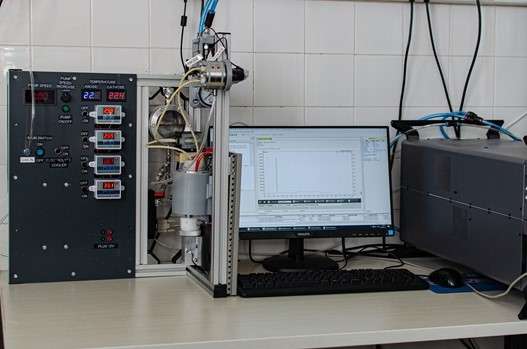Summary of the research group’s field of study
The work of the research group can be divided in four topics, that are:
Research on the fundamental aspects of CO2 electroreduction. This includes the physical/chemical and electrochemical characterization of different cell constituents, such as the used catalysts, membranes, electrode supports.
Catalyst development for neutral pH water oxidation. We aim to explore potential anode catalysts to be used in CO2 or water electrolyzer cells. We characterize the activity and stability of the catalysts with various coupled electrochemical techniques.
Studying the fundamental aspects of alternative electrode reactions that occur at lower potential compared to water oxidation, and/or result in the formation of high value products. Important examples are the oxidation of glycerol or different furanic compounds. This work includes the development of various analytical techniques.
Investigating other gas phase reactions in continuous-flow electrolyzer cells. We investigate the possible transformation of CO (potentially derived from CO2 reduction) to high value products (e.g., ethylene).
The most important scientific results of the research group
We proved, that the rate of CO2 electrolysis is strongly affected by the chemical nature and amount of cations at the cathode catalyst surface. In zero-gap electrolyzers, the cation transport occurs from the alkaline anolyte through the membrane. We have shown, that high rate CO2 electrolysis can be achieved in an alternative way by infusing the cathode of the electrolyzer with an electrolyte solution.
We proved, that during CO2 electrolysis the pH of the initially alkaline anolyte becomes close to neutral, if the solution is recirculated. This implies that nickel is not a suitable anode catalyst for CO2 electrolyzers, as its continuous dissolution contaminate the cell components.
We have developed a test protocol for evaluating potential catalyst candidates for neutral pH water electrooxidation. This includes both electrochemical measurements and the analytical and physical methods for monitoring the ion dissolution and morphological changes, accordingly.
We proved, that during electrochemical chlorate production a considerable amount of the hypochlorite intermediate is back-transformed at the cathode. Forming a thin manganese-oxide or cerium-oxide film on the cathode this parasitic reaction can be suppressed, hence the process efficiency can be increased.
Results of the last 1 year
The research group focuses on electrochemical reactions resulting in valuable product. The electrochemical reduction of CO2 to CO, and the further transformation of this latter to ethylene is among our most important aims. We also study anodic electrochemical reactions that result in valuable products and/or occur at a less negative potential compared to water oxidation.
We achieved high CO2 electroreduction rate by periodically infusing electrolyte solutions with the gas stream to the cathode of water anolyte fed CO2 electrolyzer cells. Our results and the conclusions derived were published in Nature Energy, one of the most important scientific journals of the field.1
We have shown that the initially alkaline anolyte solution is neutralized by the dissolving gas in CO2 electrolyzers. Our results emphasize, that the anode catalyst must be stable and active at close to neutral pH, and not in highly alkaline solution. The catalysts candidates must therefore be tested under relevant conditions.2,3
(1) Nat. Energy 2021, 6 (4), 439–448.
(2) ACS Energy Lett. 2021, 3801–3808.
(3) ACS Catal. 2022, 1037–1051.
The 5 most important publications of the research group
- Á. Vass; B. Endrődi; G. F. Samu; Á. Balog; A. Kormányos; S. Cherevko; C. Janáky, Local Chemical Environment Governs Anode Processes in CO2 Electrolyzers. ACS Energy Lett. 2021, 3801–3808. https://doi.org/10.1021/acsenergylett.1c01937
- B. Endrődi; A. Samu; E. Kecsenovity; T. Halmágyi; D. Sebők; C. Janáky, Operando Cathode Activation with Alkali Metal Cations for High Current Density Operation of Water-Fed Zero-Gap Carbon Dioxide Electrolysers. Nat. Energy 2021, 6 (4), 439–448. https://doi.org/10.1038/s41560-021-00813-w
- Á. Vass; B. Endrődi; C. Janáky, Coupling Electrochemical Carbon Dioxide Conversion with Value-Added Anode Processes: An Emerging Paradigm. Curr. Opin. Electrochem. 2021, 25, 100621. https://doi.org/10.1016/j.coelec.2020.08.003
- Á. Vass; A. Kormányos; Z. Kószó; B. Endrődi; C. Janáky, Anode Catalysts in CO2 Electrolysis: Challenges and Untapped Opportunities. ACS Catal. 2022, 1037–1051. https://doi.org/10.1021/acscatal.1c04978
- B. Endrődi; V. Smulders; N. Simic; M. Wildlock; G. Mul; B. Mei; A. Cornell, In Situ Formed Vanadium-Oxide Cathode Coatings for Selective Hydrogen Production. Appl. Catal. B Environ. 2019, 244, 233–239. https://doi.org/10.1016/j.apcatb.2018.11.038
Head of the research group: Dr. Balázs Endrődi

Members of the Research Group:
Bálint Árkosy
Deján Drágity
Noémi Galbicsek
Dr. Attila Kormányos
Angelika Samu
The most important tools
- Biologic VMP-300 multichannel potentiostat/galvanostat
- Shimadzu GC-2030 gas chromatograph
- Shimadzu QP2010 MS mass spectrometer coupled gas chromatograph
- SRS UGA300 atmospheric sampling mass spectrometer
- SRS BGA-244 binary gas analyzer
- Hubei Cubic-Ruiyi Gasboard-3100 gas analyzer for CO, CO2 and H2 content analysis in gas mixtures
- Bronkhorst mass flow controllers (multiple, different mass flow ranges)
- Shimadzu mass spectrometer coupled ion chromatograph
- Custom-designed and built test environment for studying gas phase electrochemical reactions
The most important figures connected to the research fields


Industrial partners
- Opus Tigáz https://www.opustigaz.hu/
- ThalesNano Zrt https://thalesnano.com/
- MOL Nyrt https://mol.hu/hu/
- GanzAir Kft https://ganzair.hu/
- eChemicles Zrt
Contact the research group leader on the following e-mail address:
endrodib@chem.u-szeged.hu
